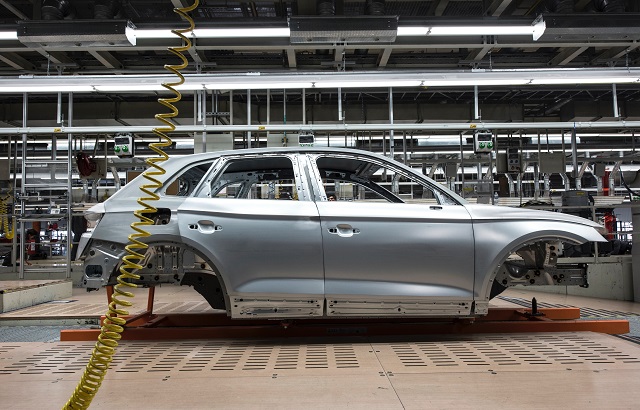After close to two years wrestling with the consequences of a global pandemic, it is clear that some industries have been hit while others have sought to rapidly adapt to new business realities, writes Axa IM robotech strategy portfolio manager Tom Riley.
For certain sectors, these unconventional conditions have actually gathered momentum behind their strategic models – it hasn’t been all plain sailing, but we believe robotics is in just such a position.
The pandemic dramatically changed the behaviour of consumers and businesses, and as a result, there has been a marked increase in demand for robotics and automation equipment in several important end markets. One is warehouse automation, as individuals have increasingly insisted on rapid and reliable delivery – something which can only be done with significant technological support.
Robots supporting such logistics had been on the rise pre-pandemic and the pace has accelerated further. Companies which had previously been slow to embrace e-commerce are now having to step up their investments in automated warehouses to support this demand.
We have long invested in this sector, through companies such as Kion and Daifuku (material handling solutions), Cognex and Keyence (vision systems) and Ocado (automated grocery).
In 2021 we added two new names to the portfolio also exposed to this trend – GXO Logistics (a warehouse operator specialising in automation) and Autostore (a manufacturer of automated storage and retrieval solutions for warehouses).
Inflation and other expanding opportunities
The current backdrop of rapid wage inflation in parts of the global economy is presenting large labour challenges, particularly in the warehousing and logistics space. Fundamentally when labour cannot be appropriately sourced, or when the cost of labour is increasing, it can make investments in automation more attractive. As the economics become more compelling, and technology improvements broaden the range of what can be automated, we see demand for automation equipment sustaining.
Labour shortages and wage increases are also impacting many other parts of the economy. According to the US Job Openings and Labour Turnover Survey, there are around 11 million jobs currently being advertised in the US compared to the six-to-seven million average in the pre-pandemic years. This high level of job openings indicates that companies are trying to source employees but struggling to find them. In many industries, labour scarcity presents an opportunity for automation to help ease these pressures – and we see this being a key driver of automation demand.
In addition, the pandemic put national healthcare systems worldwide under a lot of stress and governments have recognised that healthcare infrastructure has seen under-investment for a long time. As governments review healthcare provision there will be a large focus on technology and efficiency – and two areas poised to benefit are digital health and robotic surgery.
The market for robotic surgery is already considerable –– and it boasts a wealth of innovative firms such as market leader Intuitive Surgical whose robots performed more than 1.2 million surgical procedures in 2020 – expected to grow 27-30% in 2021, or smaller companies such as Globus Medical, which focuses on musculoskeletal implants that provide spine care solutions for patients.
Long-term structural trends remain intact
Notwithstanding the challenges of the global pandemic, the robotics sector is a disruptor, still in its infancy. The global annual supply of industrial robotics increased on average by 5% per annum between 1993 and 2008 – but between 2010 and 2024, it is estimated this yearly increase will rise to an 11% average.
Industrial activity and strong order books for industrial robotics companies bode well for a continued recovery. While recent growth has been led by China, which recovered earlier than other markets from the impact of the pandemic, we are seeing more signs of this strength broadening into Europe and Japan.
Diverse investment opportunities
There are two primary reasons why the robotics sector’s high growth rate can endure – shifting demographics and evolving technology. Ageing populations and falling numbers of working-age people are driving the need for robotics. This is well documented in Japan, but also in China where manufacturing labour costs have risen 12% per annum over the past 21 years.
Essentially labour costs are rising – particularly for low value, repetitive tasks. At the same time, robots are becoming cheaper and more flexible; as working populations contract, it provides huge potential for further robotics adoption.
At the same time we are still witnessing improvements in software and the introduction of vision systems, meaning the range of tasks that can be automated is rapidly expanding. This is opening vast new parts of the economy to automation in a way that was not previously possible; new technologies have significant growth potential in markets such as food processing, electronic products and general manufacturing.
In addition, the development of advanced sensors and microprocessors over the last decade has also allowed the introduction of collaborative robots, which can work alongside people. Meanwhile the rollout of 5G will connect industrial machines and factories in a way that we haven’t seen before.
Another area enjoying the potential for long-term growth is the electric vehicles (EV) sector. EVs are garnering more interest from consumers as the costs of the vehicles come down, battery technology improves, and individuals focus on environmental trends. Post-Covid-19 economic stimulus programmes focused on environmental technologies is also supporting the EV industry.
Huge investment is required to manufacture cars and batteries, and companies are spending money today for cars that will be produced in 12 to 24 months’ time. In our view the prospects for companies supplying equipment such as industrial robots, lasers and vison systems is markedly improving.
2022 and beyond
Looking ahead, we continue to believe that we are in the early stages of the robotics industry’s evolution.
Ultimately robots and autonomous systems have the potential to bring about significant economic effects; one analysis estimates that boosting robot installations 30% could add an extra $4.9trn per year to the worldwide global economy by 2030.
Given the huge range of companies involved in robotics, it remains a vast universe with many different opportunities, all of which are fortified by numerous long-term structural trends.
This article was written for Portfolio Adviser by Axa IM Robotech strategy portfolio manager Tom Riley







